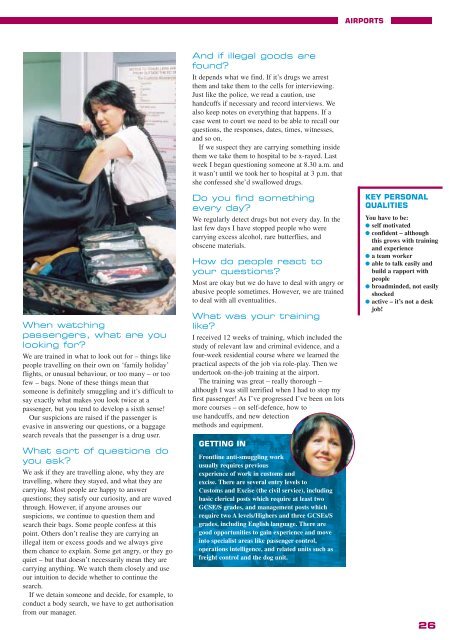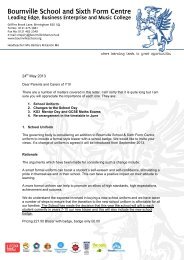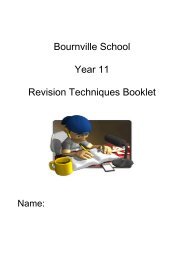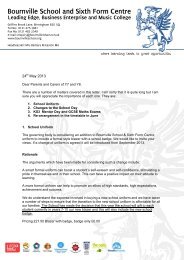You also want an ePaper? Increase the reach of your titles
YUMPU automatically turns print PDFs into web optimized ePapers that Google loves.
TOUCHDOWN<br />
Aircraft<br />
Servicing and<br />
Maintenance<br />
Engineers<br />
Wendy Allen and<br />
Kirsty Twynan<br />
Wendy and Kirsty are part of a team of engineers<br />
who undertake regular checks and servicing of<br />
aircraft – to make sure that they are safe to fly.<br />
Explain your work<br />
K: It’s our job to make sure that all parts of the<br />
aircraft are checked and any necessary repairs<br />
carried out. That includes both the exterior –<br />
undercarriage, wing flaps, fan blades, etc – and the<br />
interiors such as the seating, doors, floor and<br />
panelling.<br />
I’m a licensed engineering technician, and work<br />
as a supervisor and inspector of work. I identify any<br />
faults with the aircraft, delegate and co-ordinate the<br />
work of several aircraft mechanics, and then check<br />
that the work has been completed to the proper<br />
standards.<br />
W: I’m one of the guys! I’m an aircraft mechanic<br />
and I fix faults. For example, an inspection may<br />
have shown that some bearings need changing in<br />
the doors, or seal replacements are needed. I follow<br />
the appropriate job card, which lists the faults, tells<br />
me exactly what work to do and gives me an<br />
estimate of how long the job should take. When<br />
I’ve completed the work Kirsty inspects it.<br />
a bit more involved – we check all the aircraft’s<br />
functions, perhaps do an engine change, and repair<br />
or replace parts of the undercarriage, flaps, wings,<br />
wheel brakes or fuselage, for example. A ‘D’ check<br />
is a much more in-depth and structural inspection<br />
and can take us six to eight weeks to complete.<br />
What are your<br />
backgrounds?<br />
K: I did mechanical engineering (aircraft) at Brunel<br />
College. I came here as a mechanic, completed onthe-job<br />
training and was promoted after a year.<br />
W: I’ve worked here for nearly two years. Prior to<br />
that I was a mechanic in the RAF for nine years.<br />
What have you been doing<br />
today?<br />
K: I came in at 6.30 a.m. and received a handover<br />
of the night’s work. I carried out some inspection<br />
work, sorted out some spares, organised the work of<br />
the mechanics in my team, and then carried out<br />
some checks. I’m working on doors at the moment<br />
– making sure that they are opening and closing<br />
properly, the pressurisation is working as it should<br />
and any defects are being put right. This afternoon<br />
I’ll be working on the engines. Both engines will be<br />
taken off the aircraft and each part thoroughly<br />
checked. If I find a major problem, I may have to<br />
organise and oversee a complete engine change.<br />
W: Today I’m working on the ‘internals’ of the<br />
aircraft – not my favourite! We have to take out all<br />
the seats, the windows and the floorboards so that<br />
the aircraft’s structure can be checked and any<br />
faulty parts repaired or replaced. It’s a dirty job!<br />
Is it all routine<br />
maintenance?<br />
W: No. We occasionally get ‘casualty’ aircraft –<br />
where we don’t know quite what the problem’s<br />
going to be. For example, last week we found<br />
ourselves picking bits of flamingo out of an engine!<br />
Birds can cause a lot of damage so we had to insert<br />
a probe into the engine to make sure everything<br />
was okay.<br />
What hours do you work?<br />
K: We work seven-and-a-half hour shifts, with a<br />
break every two hours or so. There are plenty of<br />
opportunities for overtime. You have to be flexible<br />
– working throughout the night to fix a casualty<br />
aircraft if necessary.<br />
What do you enjoy most?<br />
W: The teamwork – it’s mostly guys here, but we<br />
don’t find that a problem! Also, it’s great not<br />
having to work behind a desk.<br />
K: This is a great job – if you think you’re<br />
interested just go for it! The aircraft industry is so<br />
varied and there are lots of opportunities. Once<br />
you’re qualified/licensed you can work all over the<br />
world. That’s my ambition. And ultimately I’d love<br />
to work in crash investigation, which would involve<br />
learning to fly.<br />
GETTING IN<br />
Airlines and aircraft maintenance companies may<br />
offer traineeships or Modern Apprenticeships (or<br />
equivalent). Schemes include on-the-job<br />
training and attendance at<br />
college/training school. Trainee<br />
mechanics can specialise in avionics<br />
or in airframe and engine. Entry<br />
qualifications vary, but GCSEs/S<br />
grades (with maths and science)<br />
or relevant GNVQs/GSVQs are<br />
normally required.<br />
After an average of four years’ experience<br />
/training and exams, apprentices become<br />
licensed technicians.<br />
It is also possible to enter with equivalent<br />
training with the armed forces<br />
(like Wendy), or after a full-time<br />
course in a relevant engineering<br />
subject (like Kirsty, whose course<br />
included attaining licensed status).<br />
WHAT SKILLS AND<br />
QUALITIES DO YOU<br />
NEED?<br />
● Practical skills – working<br />
with your hands, using<br />
tools and equipment.<br />
● Common sense, tackling<br />
jobs logically.<br />
● Study skills – if you want<br />
to progress.<br />
● Good at solving<br />
problems.<br />
● Able to work carefully<br />
and safely.<br />
● Confident in your work.<br />
27<br />
What sort of checks are<br />
you doing?<br />
K: It depends on the type of aircraft and whether it<br />
is in for a ‘heavy’ or a ‘light’ check. Aircraft come<br />
into the hangar for checking when they have flown<br />
a certain number of hours; and they are booked in<br />
for heavy maintenance depending on their<br />
maintenance schedule. (The Civil Aviation<br />
Authority sets intervals for servicing different<br />
types of aircraft.)<br />
For example, we do an ‘A’ check after an aircraft<br />
has flown 200 hours. This takes up to two days and<br />
involves light routine maintenance and servicing of<br />
the engines. A ‘C’ check (after 3000 flying hours) is<br />
28<br />
AIRPORTS





